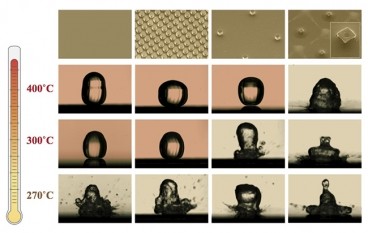When an earthquake and tsunami struck Japan’s Fukushima nuclear power plant in 2011, knocking out emergency power supplies, crews sprayed seawater on the reactors to cool them — to no avail.
One possible reason: Droplets can’t land on surfaces that hot. Instead, they instantly begin to evaporate, forming a thin layer of vapor and then bouncing along it — just as they would in a hot cooking pan.
Now, MIT researchers have come up with a way to cool hot surfaces more effectively by keeping droplets from bouncing. Their solution: Decorate the surface with tiny structures and then coat it with particles about 100 times smaller. Using that approach, they produced textured surfaces that could be heated to temperatures at least 100 degrees Celsius higher than smooth ones before droplets bounced. The findings are reported this week in the journal Applied Physics Letters.
“Our new understanding of the physics involved can help people design textured surfaces for enhanced cooling in many types of systems, improving both safety and performance,” says Kripa Varanasi, the Doherty Associate Professor of Ocean Utilization in MIT’s Department of Mechanical Engineering and the lead author of the study.
The goal for Varanasi and his co-authors, recent MIT PhD recipient Hyuk-Min Kwon and former MIT postdoc J.C. Bird, was to find a way to increase the temperature at which water droplets start bouncing. Past research indicated that rough materials would add more surface area to hold onto the droplets, making it harder for them to bounce. But the research team discovered that not just any rough surface will do.
Through systematic studies using well-defined surfaces, they found that installing microscale silicon posts on a silicon surface raised the temperature at which droplets transitioned from landing to bouncing. But it worked best when the posts were relatively diffuse. As the posts got closer together, the transition temperature gradually dropped until it was no higher than that of a smooth surface.
“That result was surprising,” says Bird, who is now an assistant professor of mechanical engineering at Boston University. “Common knowledge suggests that the closely spaced posts would provide greater surface area, so would hold onto the droplets to a higher temperature.”
By analyzing the physics involved, the researchers concluded that closely spaced posts do provide more surface area to anchor the droplets, but they also keep the vapor that forms from flowing. Trapped by adjacent posts, the accumulating vapor layer under a droplet builds up pressure, pushing the droplet off. When the force of the vapor exceeds the attractive force of the surface, the droplet starts to float.
“Bringing the posts closer together increases surface interactions, but it also increases resistance to the vapor leaving,” Varanasi says.
To decouple those two effects, the researchers coated the surface featuring spaced-out microscale posts with nanoscale particles. This “micro-nano” surface texture provides both the extensive surface area of the tiny particles and the wide spacing of the posts to let the vapor flow.
Experiments confirmed their approach. When they sprayed water on their micro-nano surfaces at 400 C — the highest temperature their experimental setup could provide — the droplets quickly wet the surfaces and boiled. Interestingly, under the same conditions, the droplets did not wet the surfaces of samples with either the microscale posts or the nanoscale texture, but did wet the surfaces of samples with both.
In addition to nuclear safety systems, this work has important implications for systems such as steam generators, industrial boilers, fire suppression, and fuel-injected engines, as well as for processes such as spray cooling of hot metal. One application now being considered by Varanasi and his colleagues is electronics cooling. “The heat fluxes in electronics cooling are skyrocketing,” Varanasi says. It might be a job for efficient spray cooling — “if we can figure out how to fit a system into the small space inside electronic devices.”
Yoav Peles, a professor of mechanical, aerospace, and nuclear engineering at Rensselaer Polytechnic Institute who was not involved in this research, says, “Extending the surface temperature at which [this phenomenon] occurs is a challenging task that has been a century-long research effort. The groundbreaking ‘hierarchical’ texture developed by Varanasi’s research group is a very promising approach to overcoming the unresolved obstacles faced by previous generations of thermal engineers.”
The research was supported by a Young Faculty Award from the Defense Advanced Research Projects Agency, the MIT Energy Initiative, and the MIT-Deshpande Center.



